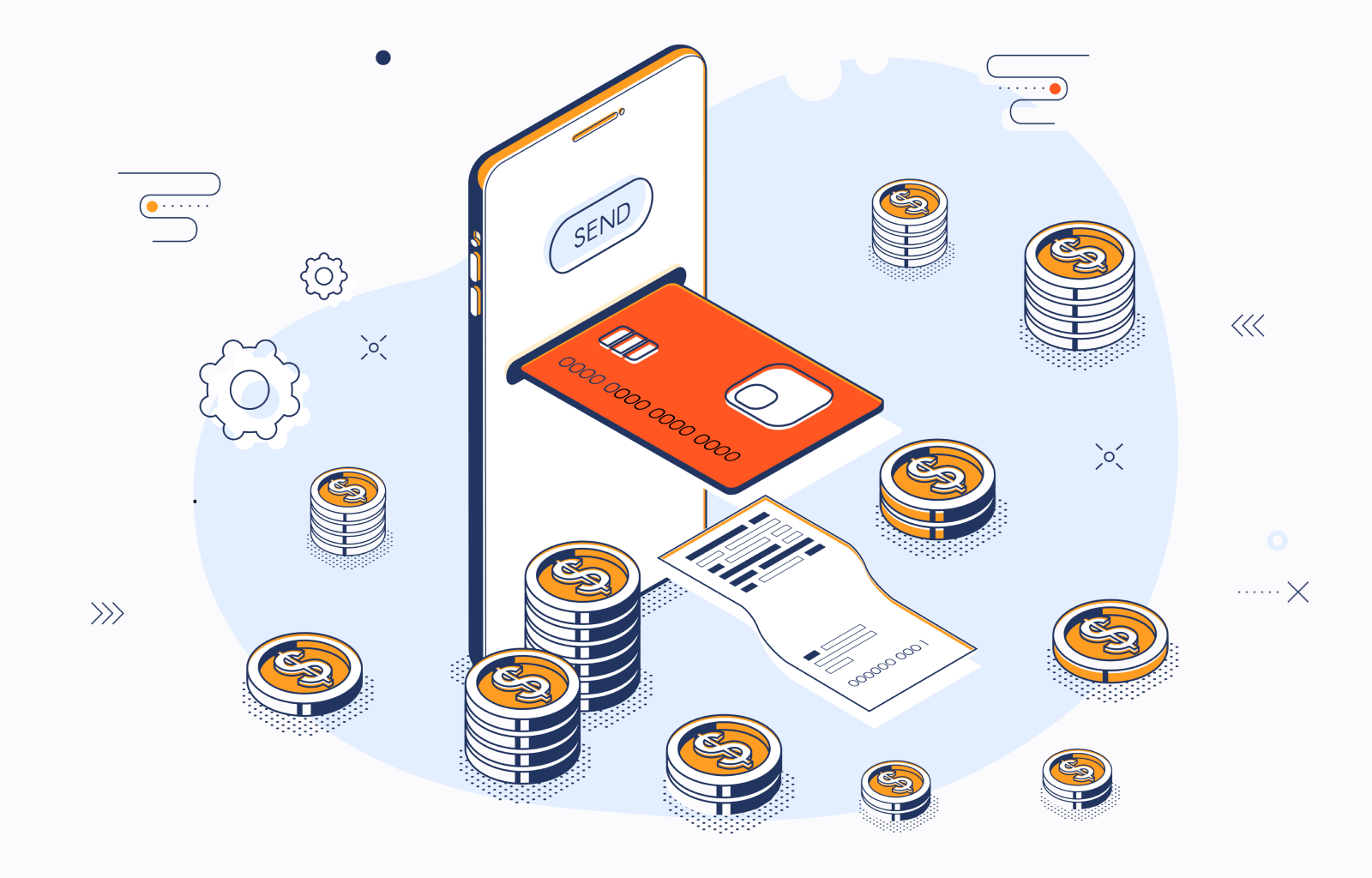How to Develop a Money Transfer App in 7 Steps

In 2023, nearly half of Canadians — 44.9% to be exact — used a mobile payment method, whether a bank account management app, digital wallet, or online payment account app. With so many relying more on digital payment solutions, there’s never been a better time to develop a money transfer app.
So, the big question is, how do you create one? This guide will cover seven key steps, from validating ideas to successful deployment. It’ll also hint at the must-have features and opportunities that come with such applications.
The Purpose of a Money Transfer App
A money transfer app simplifies and speeds up the process of sending or receiving money. Whether splitting a dinner bill, paying rent, or transferring funds to family overseas, such applications streamline transactions, replacing traditional payment methods like cash.
The distinguishing features of money transfer software are:
Speed. Make transfers almost instantly without dealing with delays common for traditional payments.
Convenience and accessibility. Let users send and receive money anytime, anywhere, with just a few taps on their smartphones.
Global reach. Enable cross-border transfers and support various currencies for international users.
By fulfilling these objectives, a fintech app for money transfers impacts the banking and overall financial industry, changing how people handle their funds.
The Relevance of Building a Money Transfer App
Money transfer apps are currently taking off. In 2023, the market was worth $22.5 billion and is expected to surpass $60 billion by 2030. Several factors contribute to this growth:
Peer-to-peer (P2P) payment boom. The P2P payment market, valued at $2.21 trillion in 2022, is set to hit around $11.62 trillion by 2032. More people are now looking for ways to pay each other directly rather than turning to traditional banking.
Global potential. Looking at where P2P payments are happening, Asia Pacific leads with 34% of the market share, followed by North America (30%), Europe (25%), Latin America (6%), and the Middle East and Africa (5%). That highlights the significant opportunities for money transfer app development worldwide.
Cashless transactions. Particularly in Canada, the shift to cashless transactions has been noticeable. The percentage of Canadians who consider themselves entirely cashless peaked at 19% in 2020 and settled at around 13% in 2023.
Cross-border payments growth. The digital remittance market, typically associated with international money transfers, is also expanding rapidly. From $19 billion in 2022, it’s projected to reach over $77 billion by 2032.
Expanding financial inclusion. Around 76% of adults now have a bank or mobile account, up from just 51% in 2011. This increase in access is driving up the demand for user-friendly money transfer apps.
Types of Money Transfer Apps
Developing a money transfer app isn’t just about P2P payments (though it can include them as a core feature). You can consider various types of money transfer applications. Let’s go through the most popular options:
Peer-to-Peer Payment Apps
P2P apps handle quick and easy money transfers between individuals. They have become an excellent solution for person-to-person payments, splitting bills, and even small purchases.
Examples: Venmo, PayPal, Cash App
International Money Transfer Apps
These apps offer cross-border transactions, meaning individuals and businesses can send money to recipients in other countries. They typically feature competitive exchange rates, fast transfer speeds, and currency conversion capabilities.
Examples: Wise, Western Union, Remitly
Mobile Banking Apps
Mobile banking apps are an extension of the traditional bank ecosystem. They offer various banking services, including bill payments, account management, and money transfer capabilities.
Examples: Bank of America Mobile Banking, Citi Mobile, HSBC Mobile Banking
Social Payment Apps
These apps blend social media with payment functionalities, allowing users to interact socially and send money to each other.
Examples: WeChat Pay, Meta Pay
Must-Have Features of a Money Transfer Application
Before you learn to create a money transfer app, explore the features it may include. The must-have functionalities are as follows:
E-Wallets
With e-wallets (electronic wallets), users store their payment information and funds. They should support various payment methods (bank transfers, debit/credit cards, cash deposits), fund withdrawals (to a bank account or in cash), and balance checking.
Profile Management
A profile management feature is necessary for user convenience and personalization. It must include a simple signup process and the ability to add and edit personal information. Security settings like two-factor or biometric authentication and strong passwords are also crucial.
Customer Support
Customer support is essential for any money transfer system, whether users run into problems or just have questions. Offer it through email, phone, social media, FAQs, and ticketing systems. And if you want to take it to the next level, you could use AI in fintech for convenient live chat support.
Notifications and Alerts
Notifications and alerts keep users informed about their transactions and account activity. These include transaction confirmations, payment reminders, security alerts, low-balance alerts, and promotions. Ensure users can customize their notification preferences. People may want to pick which alerts they get and how the app delivers them.
Transaction History and Tracking
Users should be able to review their past transactions. Include detailed transaction records (with dates, amounts, and statuses) and the ability to search and filter transaction history. Also, provide the opportunity to download transaction history reports.
Payment Statistics
With payment statistics, users can track their spending and transaction patterns. It typically features spending analysis, categorized expenses, budgeting tools, and the ability to set financial goals.
Integration with Bank Accounts
Thanks to this feature, users connect their bank accounts to your money transfer app. This way, you’ll increase their convenience significantly.
Security
Security measures are indispensable for money transfer apps, given the sensitive nature of the finance industry. To protect user funds and personal details, implement data encryption, fraud detection mechanisms, strong password requirements, and multi-factor authentication. Also, adhere to PCI DSS, ISO 20022, AML/KYC, and other relevant regulations.
Check out our other best practices for secure fintech development to learn more.
International Transfers and Currency Exchange
If your platform targets international users, include multiple currency support and real-time exchange rates. Offer favorable exchange rates and enable fast transactions to attract more customers.
How to Develop a Money Transfer App? Mobile Version Example
Usually, developing a money transfer app takes seven steps. Let’s discuss each in detail:
01.Idea Validation
Before you hire a fintech software development company, validate your money transfer app idea. It typically involves the following:
Identify your target market (the specific demographic or geographic area you want to cater to).
Create a value proposition (what makes your app stand out).
Evaluate the technical and financial feasibility of your idea.
02.Market Research
Once you validate your idea, move on to exploring your app’s viability in greater depth. To do that, handle thorough market research:
Study how people currently send and receive money to determine pain points.
Weigh the strengths and weaknesses of existing money transfer apps.
Monitor emerging technologies and consumer preferences in the financial sector.
03.App Platform Selection
The next crucial step is to choose the appropriate platform, depending on your target audience’s needs. Pick either native iOS or Android or opt for cross-platform development. When deciding, consider each option’s pros and cons, the development tools and libraries available, and your budget constraints.
04.UI/UX Design
At this stage, you create an interface for your money transfer app. Focus on a design that is easy to navigate, visually appealing, consistent, and compatible with different mobile devices and screen sizes.
05.App Development
With the design in place, move on to custom app development. Critical aspects of this stage include the following:
Select a suitable technology stack.
Build your app’s server side.
Handle mobile development.
Integrate with payment gateways, banks, and other financial services.
Implement security measures.
06.Testing
The testing stage is necessary to identify and fix bugs before your money transfer app’s launch. Conduct the following:
Functional testing to make sure all features work as planned
Usability testing to ensure seamless user experience
Security testing to evaluate your app’s potential vulnerabilities to security threats
Performance testing to check app performance under different conditions
Compatibility testing to ensure your app works well on different devices
07.App Store Deployment
Once testing is complete, submit your app to the Apple App Store and/or Google Play Store. Follow the specific requirements and policies of each marketplace and provide attractive app descriptions and screenshots.
Conclusion
Money transfer app development has never been more relevant, given the growing popularity of P2P payments, cashless transactions, and cross-border deals. However, this process requires in-depth market understanding, technological expertise, and dedication to user experience.
If you want to create a money transfer app hassle-free, count on our fintech software development services. For over two decades, we’ve built financial software, including money transfer apps. Contact us today to change how people send and receive money forever.
FAQ
The time for money transfer app development depends on the app’s complexity, desired features, and the size of your development team. Generally, a basic MVP takes three to six months, while a fully featured app can take six months to a year or longer.
Before developing a money transfer app, consider the following aspects:
Validate your app’s idea.
Conduct market and competitor research.
Determine your business model.
Explore applicable financial regulations and licensing requirements.
The tech stack for money transfer app development typically includes:
Frontend development: React Native, Flutter, Swift, and Kotlin
Backend development: Node.js, Django, and Ruby on Rails
Database management: PostgreSQL and MongoDB
Third-party integrations like Stripe, PayPal, and banking APIs
Security measures: SSL/TLS, data encryption, and secure coding practices
You can look for white-label payment solutions to create a money transfer app without starting from scratch. After purchasing one, you’ll only need to customize it to your brand.
Similar to the development timeframe, the cost to build a money transfer app depends on several factors:
Technical complexity
Design complexity
Development team size
Tech stack
Contact us

